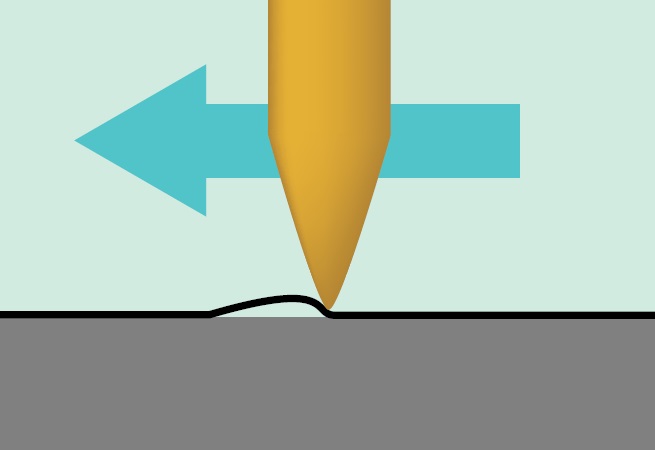A new wrinkle in sliding friction?
Drs. Wilfred T. Tysoe & Nicholas D. Spencer | TLT Cutting Edge February 2011
The friction of a monolayer of layered materials is found to be higher than multiple layers due to puckering of the thinner films during sliding.

For the thinnest (monolayer) films, a wrinkle forms during sliding at the leading edge of the tip.
Layered compounds such as graphite and molybdenum disulfide (MoS
2) have been used as solid lubricants for many years. Recently it has been discovered that a single, atomically thick sheet of graphite, dubbed graphene, had properties that are quite distinct from those of the bulk material. It has an extremely high electrical conductivity, is remarkably strong and, in spite of its thinness, is impervious to gases.
Graphene has a myriad of potential technological applications from transistors that are a few nanometers across to efficient and cheap photovoltaics. In recognition of the fundamental and technological importance of graphene, this year’s Nobel Prize in Physics was awarded to Andre Geim and Konstantin Novoselov of the University of Manchester (U.K.), who discovered that graphene could be easily made by “exfoliating” graphite. That is, single graphene layers could be pulled from bulk graphite by using a piece of adhesive tape.
In view of the unusual properties found for graphene, professor Rob Carpick and his group from the University of Pennsylvania, along with professor Jim Hone of Columbia University and collaborators, wondered how the friction of a single layer of a layered compound would differ from that of the bulk material. They used atomic force microscopy (AFM) to explore this question for several layer compounds with different electrical properties, which include graphene (a semimetal), molybdenum disulfide (a semiconductor), hexagonal boron nitride (an insulator) and niobium diselenide (a metal). All of these compounds are deposited onto an oxidized silicon substrate. The first three have been used as solid lubricants.
AFM is the ideal tool for such experiments since the number of layers in the film can be measured by imaging the sample in contact mode, and the friction can be measured from the torsion of the cantilever during sliding. In all cases, a single atomic layer was found to have higher friction than multiple layers and friction decreased to the bulk value for a film of about four to five layers thick.
The group carried out a number of control experiments to Identify possible origins for the variation in friction. Since all materials showed the same trend, their electronic properties were not important in causing the friction effect. They also excluded the effects of load, sliding speed, tip material and humidity. The effect of the support was excluded by performing similar experiments for sheets suspended over holes in the substrate, but the same trend was still observed. The effect was entirely due to the thickness of the film.
The origin of the observed behavior was identified by carrying out simulations of a tip sliding across a flexible membrane. Carpick and colleagues discovered that for the thinnest (monolayer) films, a wrinkle forms during sliding at the leading edge of the tip. This disappears as the film becomes thicker. It is suggested that the puckering of the thin substrate results in a higher contact area between the tip and substrate, resulting in the higher friction forces observed experimentally.
The authors suggest that these results can lead to the rational design of such monolayer materials in nanomechanical applications, ensuring that the monolayer sheet is strongly enough attached to the substrate to prevent it from buckling.
FOR FURTHER READING:
Lee, C., Li, Q., Kalb, W., Liu, X.-Z., Berger, H., Carpick, R.W and Hone, J. (2010), “Frictional Characteristics of Atomically Thin Sheets,”
Science,
328, pp. 76-80.
 Eddy Tysoe is a Distinguished Professor of Physical Chemistry at the University of Wisconsin-Milwaukee. You can reach him at wtt@uwm.edu
Eddy Tysoe is a Distinguished Professor of Physical Chemistry at the University of Wisconsin-Milwaukee. You can reach him at wtt@uwm.edu.
 Nic Spencer is professor of surface science and technology at the ETH Zurich, Switzerland. Both serve as editors-in-chief of STLE-affiliated Tribology Letters journal. You can reach him at nspencer@ethz.ch
Nic Spencer is professor of surface science and technology at the ETH Zurich, Switzerland. Both serve as editors-in-chief of STLE-affiliated Tribology Letters journal. You can reach him at nspencer@ethz.ch.